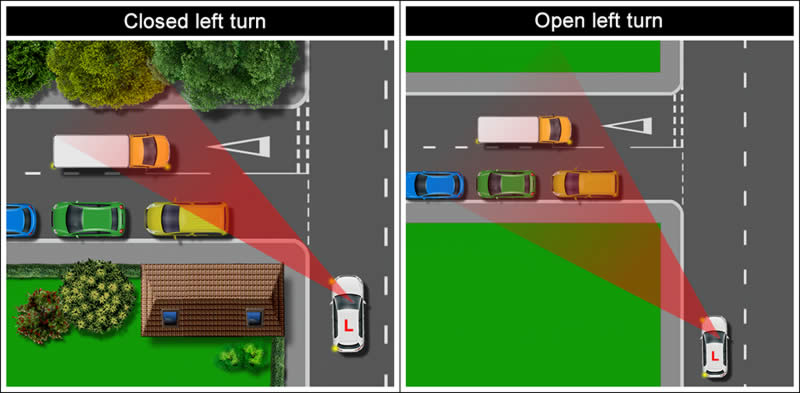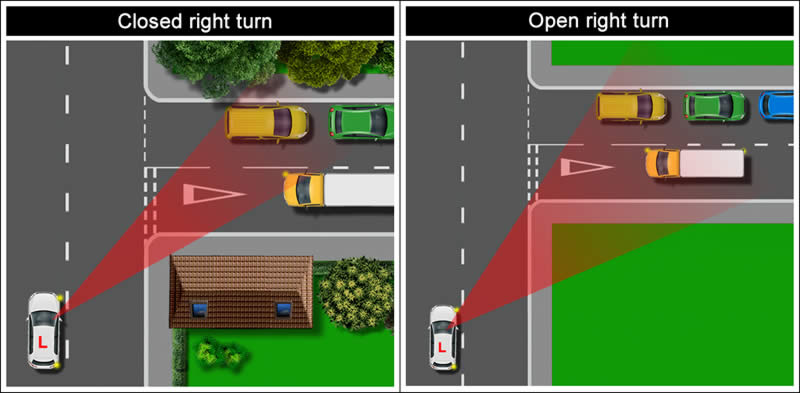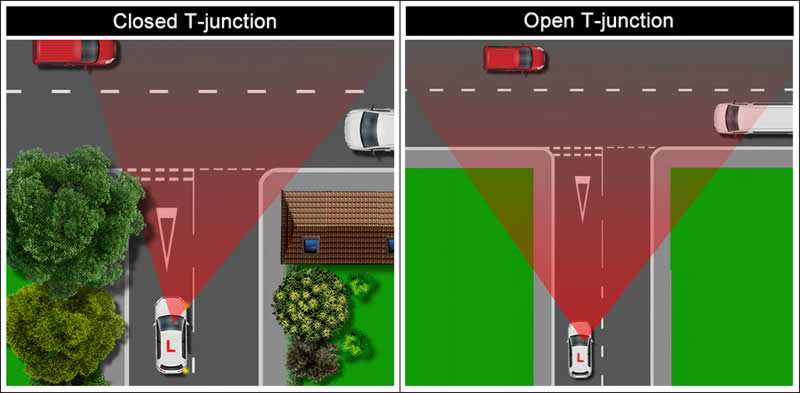Whilst learning to drive, observational skills help you to assess each and every situation. One key component of junctions, is understanding the difference between open and closed junctions. Anticipation and planning will then play its part in how to deal with each junction that you negotiate.
Difference Between Open and Closed Junctions
In simple terms, the difference between an open and closed junction is how clear the junction is to observe (open) or how your view of the junction is obscured (closed).
Open and Closed Left Turns
At the early stages of learning to drive, you’ll usually begin negotiating junctions in the form of left and right turns. In this example of a left turn, the red shaded area denotes an approximate view of what the learner driver in the white car can see.

In the diagram of the closed left turn, their view is obscured. Their view of the parked cars in the left turn only becomes apparent just before they make the turn. In the diagram of the open left turn, the driver can see the parked cars well before the junction.
The parked cars would be considered a hazard due to the learner driver having to potentially stop for oncoming vehicles. Before making the left turn, the driver should assess the junction early on to determine whether it’s open or closed. If it’s closed, they need to anticipate what hazards may be in the new road and plan accordingly. Whether or not the junction is open or closed will determine the speed in which you enter the new road.
Open and Closed Right Turns
In a similar scenario, but this time of a right turn, in the right turn, the learner driver can see the parked cars and the approaching van much sooner.

Open and Closed T-junctions
When approaching a T-junction, you’ll also need to assess whether it’s open or closed as this will determine the speed at which you approach the junction and what actions you take when you get there.

Because the driver’s view of the road ahead is obscured at a closed T-junction, they will need to approach slowly and be prepared to stop just before the give way lines.
If the T-junction is open, the driver might be able to see that the road is clear from approaching traffic before they reach the junction line. In this instance, the driver might be able to continue through the junction and into the new road without having to stop.
Open and Closed Roundabouts
Roundabouts are another form of common junction. They’re often ‘open’ to help prevent accidents, but in built-up towns and cities, mini roundabouts are common place.

In the diagram of the closed mini roundabout above, the learner driver’s view to the right is obscured by trees and they should approach the roundabout a little slower than they would if it was open. In a town or city environment, junctions can be closed and obscured by walls, hedges, trees, parked vehicles or buildings.
Why are Closed Junctions More Hazardous?
Closed junctions are more hazardous because they can obscure parked cars, cyclists or pedestrians crossing the road. Always adjust your car’s speed based on what you can or cannot see. If you approach a closed junction slowly, it’ll provide you with more time to react to hazards.
Learning to Drive at Junctions
Junctions can be challenging and complex and take a lot of practice. for further information about the different types of junctions, see learning to drive: junctions.
Tips for Private Practice
![]() During the driving test, the examiner will be taking the test candidate through many junctions. If you’re giving a learner driver private practice, read up on our tips for teaching open and closed junctions.
During the driving test, the examiner will be taking the test candidate through many junctions. If you’re giving a learner driver private practice, read up on our tips for teaching open and closed junctions.